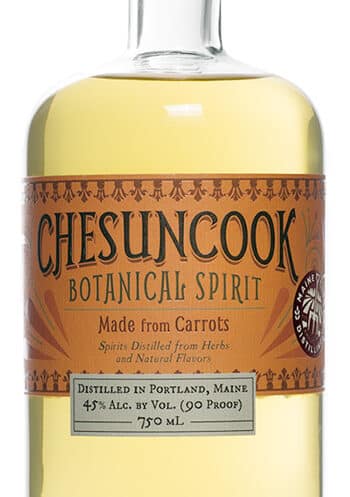A treatise on Fermented Liquors from 1858 claims that “[carrots] — this makes a very wholesome wine; needs very little sugar to produce fermentation.” A receipt book published by “A. lady” provides a recipe for 18 gallons of carrot wine. It starts out as 120 pounds (!) of carrots.
In short, though the idea of fermenting carrots may seem obscure to us but recipes such as the above were common in cookery books during the 19th century. The folks at Maine Craft Distilling are basing their Chesuncook Botanical Spirit on a forgotten tradition. The base spirit is made from carrots.
Tasting Notes
Chesuncook Botanical Spirit is goldenrod with a slight orange tinge. It’s not too literally carrot colored, but once you know the story you’ll probably think it.
The nose is intensely earthy and a touch fruity as well. I’m getting notes of applejack, brewery grain, and barley spirit. It’s complex and malt-driven. The nose of Chesuncook Botanical Spirit suggests a gin in the spirit of genever, or Holland style/ginever style gins.
The palate adds some botanical color. My first impression on a casual sip is how cool menthol seems to mellow the grain and fruit base. It suggests to me something between a pear brandy and a barley vodka. Peppery nuance early, juniper and cubeb notes. The mid-palate is where the mint starts to come on as well ad some savory spice. I get coriander certainly, but also some hints of fennel seed and wheat. There’s a slight hint of carrot here.
Chesuncook Botanical Spirit is not too literal on the palate with its base though. Towards the finish, there’s a pleasant warmth, as well as some notes of parsnip and stewed celery. The finish is medium length with spearmint and sweet vegetal notes. I find that it does leave a lasting impression of pureed carrot soup after I finish.
But as unusual as it is, Chesuncook Botanical Spirit does an excellent job using the base spirit as a botanical and building a gin around it.
Cocktails
I do admit to taking a look at what the folks at Maine Craft Distilling suggested to do as for mixing. Their Sin of Men, while perhaps a bit of work because no one— save the craftiest craft cocktail bars— has chili simple syrup just sitting around. However, the combination of the chili and the gin work really well together.
Maine Craft Distilling’s cocktails opt for the more vegetal, which I found to perhaps be the most complementary. For example, make a Gin and Tonic, but garnish it with a cucumber. Or amp up the mint notes for a Southside. Perhaps where I think Chesuncook Botanical Spirit might work best is in the Red Snapper. It has enough botanical character to come through and add to an otherwise loud cocktail.
Overall
If The Gin is IN was about recognizing ingenuity, Chesuncook Botanical Spirit would win double gold. It’s unusual and worth seeking out if you’re a spirits geek in general. You don’t need me to tell you that this is worth finding.
As a gin, it’s hard to suggest it can be used as a gin. As the name of the spirit suggests although Chesuncook Botanical Spirit is technically a gin, it’s best marketed as something else. Because if you come in expecting this to be a gin alone, you’ll be left wanting.
For those who are bold, adventurous and want to try something unusual, but also really well done. Check out Chesuncook Botanical Spirit. It’s perhaps more for those who like Holland-style and Genevers among gin drinkers. But it’s also a must-try for spirits enthusiasts.
Recommended in its category.
Thanks to….
Special thanks to John at Foodie Pilgrim. Since 2012, John has shared and sourced gins from New England and nearby that we at The Gin is In haven’t tried yet. This gin sample was shared by John, who is also a big fan of gin. So check out his New England Gin Reviews as well when you have a chance.

